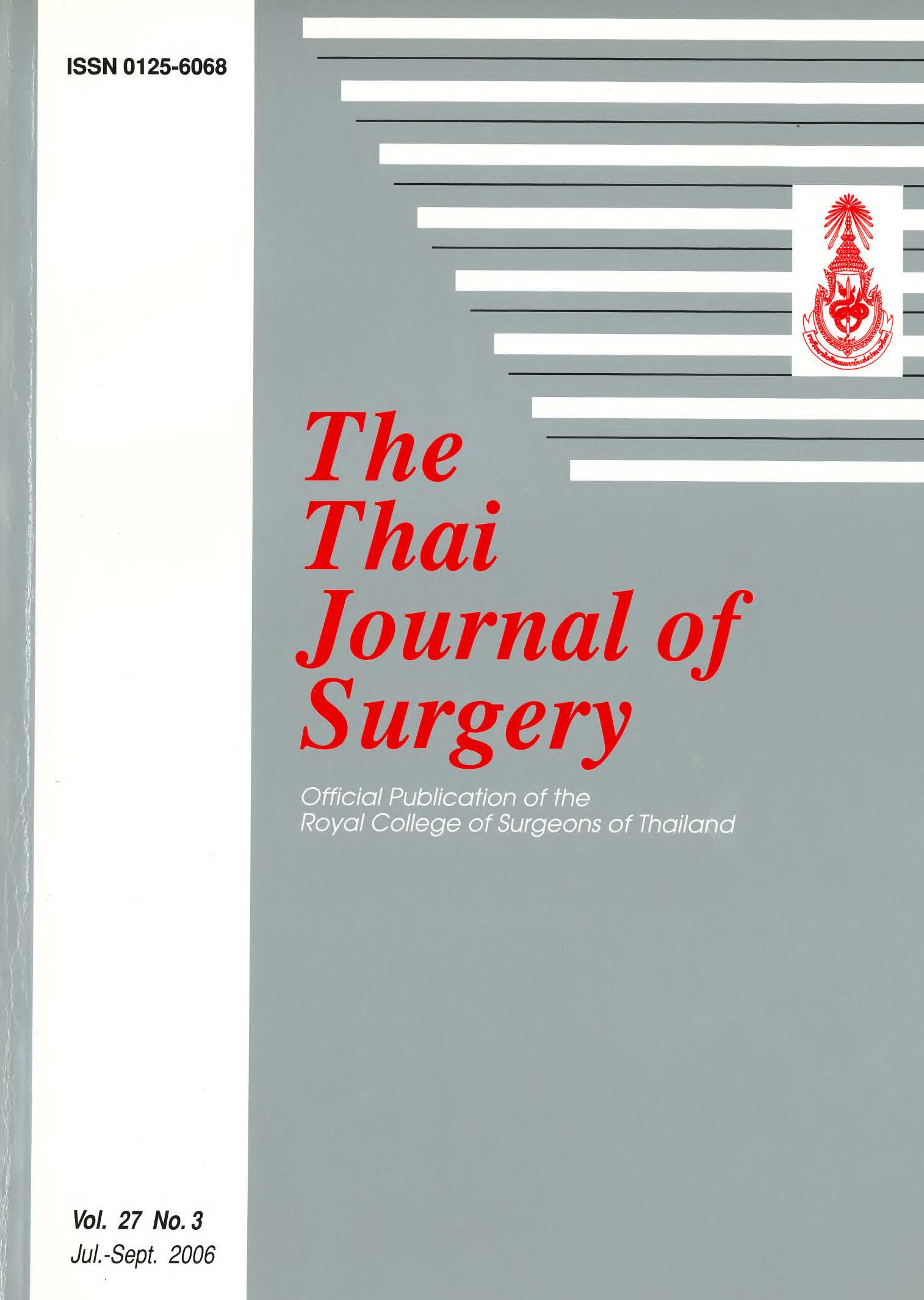Ileal Ulcer Perforation Caused by Non-Tuberculous Mycobacterial Infection in HIV Infected Patient: A Case Report
Abstract
Introduction: One of the common opportunistic infections in HIV infected patients in Thailand is Mycobacterium Tuberculosis. The most common manifestation is pulmonary infection. In HIV infected patients with acute abdominal condition, gastrointestinal tuberculosis is usually one of the differential diagnoses, and sometimes can mislead the diagnosis of non-tuberculous mycobacterial (NTM) infection.
Case Report: A 36-year-old male presented at Bamrasnaradura Institute with chronic diarrhea, fever and weight lost. He was a homosexual and had had history of HIV infection for 2 years without treatment. The provisional diagnosis was chronic diarrhea with HIV infection. His stool was sent for modified acid fast staining and culture for mycobacterium. The modified acid fast staining result was positive. Gastrointestinal tuberculosis was then diagnosed and he was treated by anti-tuberculosis drugs. After four weeks of anti-tuberculosis drugs, he was started on anti-retroviral drugs. Five months after the treatment, he came back with severe abdominal pain and signs of generalized peritonitis. He underwent emergency abdominal exploration which revealed a short segment of ileal stricture, a perforated ileal ulcer 3 feet proximal to ileo-caecal valve with multiple mesenteric lymphadenopathy. Right half colectomy was performed. The patient went home seven days later without complications. Histopathological examination revealed subacute ulcerated areas with perforation in the terminal ileum. Chronic caseating granulomatous inflammation suggestive of mycobacterial infection was also found. After reviewing this patient's medical records and laboratory results, we found that his stool culture for mycobacterium on his first visit was positive for non-tuberculous mycobacterium.
Discussion: Non-tuberculous mycobacterial gastrointestinal infection can cause similar manifestations as of Mycobacterium Tuberculosis gastrointestinal infection. Stool examination for modified acid fast staining only may not be enough to give the correct diagnosis. Stool culture or stool PCR for Mycobacterium Tuberculosis should be performed to confirm the diagnosis of gastrointestinal mycobacterial infection, because the medications are different for different species of Mycobacterium.
References
2. Ledergerber B, Egger M, Erard V, et al. AIDS-related opportunistic illnesses occurring after initiation of potent antiretroviral therapy: the Swiss HIV Cohort Study. JAMA 1999:282:2220-6.
3. Badri M, Ehrlich R, Wood R, et al. Association between tuberculosis and HIV disease progression in a high tuberculosis prevalence area. Int J Tuberc Lung Dis 2001: 5: 225-32.
4. Barnes PF. Rapid diagnostic tests for tuberculosis: progress but no gold standard. Am J Respir Crit Care Med 1997; 155:1497-8.
5. Burman WJ, Jones BE. Treatment of HIV-related tuberculosis in the era of effective antiretroviral therapy. Am J Respir Crit Care Med 2001; 164: 7-12.
6. Chapman AL, Munkanta M, Wilkinson KA, et al. Rapid detection of active and latent tuberculosis infection in HIV-positive individuals by enumeration of Mycobacterium tuberculosis-specific T cells. Aids 2002; 16: 2285-93.
7. Colebunders R, Lambert ML. Management of co-infection with HIV and TB. Br Med J 2002; 324: 802-3.
8. Aberg JA, Yajko DM, Jacobson MA. Eradication of AIDS- related disseminated mycobacterium avium complex infection after 12 months of antimycobacterial therapy combined with HAART, J Infect Dis 1998; 178: 1446-9.
9. Aberg JA, Williams PL, Liu T, et al. A study of discontinuing maintenance therapy in human immunodeficiency virus-infected subjects with disseminated Mycobacterium avium complex: AIDS Clinical Trial Group 393 Study Team. J Infect Dis 2003;187: 1046-52.
10. Benson CA, Williams PL, Currier JS, et al. A prospective randomized trial examining the efficacy and safety of clarithromycin in combination with ethambutol, rifabutin, or both for the treatment of disseminated Mycobacterium avium complex disease in persons. Clin Infect Dis 2003; 37:1234-43.
11. Chaisson RE, Benson CA, Dube MP, et al. Clarithromycin therapy for bacteremic Mycobacterium avium complex disease. A randomized, double-blind, dose-ranging study in patients with AIDS. Ann Intern Med 1994; 121: 905-11.
12. Currier JS, Williams PL, Koletar SL, et al. Discontinuation of Mycobacterium avium complex prophylaxis in patients with antiretroviral therapy-induced increases in CD4+ cell count. Ann Intern Med 2000;133: 493-503.
13. Shafran SD, Mashinter LD, Phillips P, et al. Successful discontinuation of therapy for disseminated Mycobacterium avium complex infection after effective antiretroviral therapy. Ann Intern Med 2002; 137: 734-7.
Downloads
Published
How to Cite
Issue
Section
License
Articles must be contributed solely to The Thai Journal of Surgery and when published become the property of the Royal College of Surgeons of Thailand. The Royal College of Surgeons of Thailand reserves copyright on all published materials and such materials may not be reproduced in any form without the written permission.



